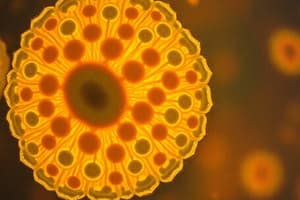Podcast
Questions and Answers
Paracrine signals act on the same cell that produces them.
Paracrine signals act on the same cell that produces them.
False (B)
Adult stem cells have more differentiation potential than embryonic stem cells.
Adult stem cells have more differentiation potential than embryonic stem cells.
False (B)
The M Checkpoint in the cell cycle ensures proper chromosome alignment before division.
The M Checkpoint in the cell cycle ensures proper chromosome alignment before division.
True (A)
Apoptosis is a process that eliminates cells without causing inflammation.
Apoptosis is a process that eliminates cells without causing inflammation.
Cellular theory states that all cells arise from newly formed cells.
Cellular theory states that all cells arise from newly formed cells.
Eukaryotic cells are distinguished by the absence of a nucleus.
Eukaryotic cells are distinguished by the absence of a nucleus.
Mitochondria are known as the powerhouse of the cell because they produce ATP.
Mitochondria are known as the powerhouse of the cell because they produce ATP.
Ribosomes in a cell are exclusively found attached to the smooth endoplasmic reticulum.
Ribosomes in a cell are exclusively found attached to the smooth endoplasmic reticulum.
The Golgi apparatus is responsible for the digestion of macromolecules within the cell.
The Golgi apparatus is responsible for the digestion of macromolecules within the cell.
Meiosis results in four identical daughter cells.
Meiosis results in four identical daughter cells.
Catabolism refers to the synthesis of complex molecules in the cell.
Catabolism refers to the synthesis of complex molecules in the cell.
Chloroplasts are found in animal cells and are involved in cellular respiration.
Chloroplasts are found in animal cells and are involved in cellular respiration.
The cytoplasm is a jelly-like substance that holds organelles in place.
The cytoplasm is a jelly-like substance that holds organelles in place.
Flashcards are hidden until you start studying
Study Notes
Cell Biology
Basic Unit of Life
- Cells are the fundamental units of life, forming the structural and functional basis of all living organisms.
- Types of cells:
- Prokaryotic: No nucleus, smaller, unicellular (e.g., bacteria).
- Eukaryotic: Nucleus present, larger, can be unicellular or multicellular (e.g., plants, animals).
Cell Structure
-
Cell Membrane:
- Semi-permeable barrier that controls entry and exit of substances.
- Composed of a lipid bilayer with embedded proteins.
-
Nucleus:
- Contains genetic material (DNA).
- Controls cell activities and gene expression.
-
Cytoplasm:
- Jelly-like substance where organelles are suspended.
- Site of metabolic reactions.
-
Organelles:
- Mitochondria: Powerhouse of the cell, site of ATP (energy) production.
- Ribosomes: Sites of protein synthesis, can be free-floating or attached to the endoplasmic reticulum.
- Endoplasmic Reticulum (ER):
- Rough ER: Studded with ribosomes, involved in protein synthesis and processing.
- Smooth ER: Lacks ribosomes, involved in lipid synthesis and detoxification.
- Golgi Apparatus: Modifies, sorts, and packages proteins and lipids for secretion or use within the cell.
- Lysosomes: Contain enzymes for digestion of macromolecules and waste.
- Chloroplasts (in plant cells): Site of photosynthesis, contain chlorophyll.
Cell Division
-
Mitosis:
- Process of cell division producing two identical daughter cells.
- Stages: Prophase, Metaphase, Anaphase, Telophase.
-
Meiosis:
- Specialized form of cell division that produces gametes (sperm and eggs).
- Involves two rounds of division resulting in four non-identical daughter cells.
Cellular Metabolism
- Catabolism: Breakdown of molecules to produce energy.
- Anabolism: Synthesis of compounds needed by the cell.
- ATP (Adenosine Triphosphate): Main energy currency of the cell.
Cellular Communication
- Cells communicate through signaling molecules and receptors.
- Types of signaling:
- Autocrine: Signals act on the same cell that produces them.
- Paracrine: Signals act on neighboring cells.
- Endocrine: Hormones released into the bloodstream to target distant cells.
Cell Cycle Regulation
- The cell cycle is regulated by a series of checkpoints:
- G1 Checkpoint: Checks for cell size, nutrients, and DNA integrity.
- G2 Checkpoint: Checks for DNA replication and damage.
- M Checkpoint: Ensures proper chromosome alignment before division.
Apoptosis
- Programmed cell death, a crucial process for maintaining homeostasis and development.
- Involves a cascade of molecular events leading to cell shrinkage and death.
Stem Cells
- Undifferentiated cells with the ability to differentiate into various cell types.
- Types:
- Embryonic Stem Cells: Pluripotent, can become any cell type.
- Adult Stem Cells: Multipotent, limited differentiation potential.
Cellular Theory
- States that:
- All living organisms are composed of cells.
- The cell is the basic unit of life.
- All cells arise from pre-existing cells.
Basic Unit of Life
- Cells are the essential units of life, serving as the structural and functional foundation for all life forms.
- Prokaryotic cells lack a nucleus, are smaller, and are typically unicellular (e.g., bacteria).
- Eukaryotic cells possess a nucleus, are more complex, and can be unicellular or multicellular (e.g., plants and animals).
Cell Structure
- Cell Membrane:
- Semi-permeable barrier regulating the movement of substances in and out of the cell; composed of a lipid bilayer with embedded proteins.
- Nucleus:
- Houses genetic material (DNA), coordinating cell functions and gene expression.
- Cytoplasm:
- Jelly-like fluid that suspends organelles and is the site for metabolic processes.
- Organelles:
- Mitochondria: Known as the powerhouse of the cell, involved in ATP production.
- Ribosomes: Sites for protein synthesis; can be found free in the cytoplasm or attached to the endoplasmic reticulum.
- Endoplasmic Reticulum (ER):
- Rough ER: Contains ribosomes, crucial for protein synthesis and processing.
- Smooth ER: Lacks ribosomes, involved in lipid synthesis and detoxifying harmful substances.
- Golgi Apparatus: Modifies, sorts, and packages proteins and lipids for intracellular use or secretion.
- Lysosomes: Enzyme-containing organelles responsible for macromolecule digestion and waste processing.
- Chloroplasts (in plant cells): Organelles where photosynthesis occurs, containing chlorophyll for light absorption.
Cell Division
- Mitosis:
- Cell division process resulting in two genetically identical daughter cells, comprising stages: Prophase, Metaphase, Anaphase, and Telophase.
- Meiosis:
- Specialized division yielding gametes (sperm and eggs), featuring two rounds of division producing four genetically diverse daughter cells.
Cellular Metabolism
- Catabolism: Breakdown of complex molecules to release energy.
- Anabolism: Process of synthesizing compounds required by the cell.
- ATP (Adenosine Triphosphate): The primary energy currency of the cell, providing energy for various cellular functions.
Cellular Communication
- Cells utilize signaling molecules and receptors for communication.
- Types of Signaling:
- Autocrine: Signals influence the same cell that produces them.
- Paracrine: Signals affect nearby, neighboring cells.
- Endocrine: Hormonal signals released into the bloodstream target distant cells.
Cell Cycle Regulation
- The cell cycle is overseen by checkpoints ensuring proper cell growth and DNA integrity:
- G1 Checkpoint: Assesses cell size, nutrient availability, and DNA integrity.
- G2 Checkpoint: Ensures successful DNA replication and checks for damage.
- M Checkpoint: Guarantees accurate chromosome alignment before cell division.
Apoptosis
- Programmed cell death is crucial for maintaining cellular balance and development.
- Involves a sequence of molecular events leading to cell shrinkage and eventual death.
Stem Cells
- Undifferentiated cells with the capability to develop into various cell types.
- Types:
- Embryonic Stem Cells: Pluripotent, capable of differentiating into any cell type.
- Adult Stem Cells: Multipotent, with a more limited capacity for differentiation.
Cellular Theory
- Fundamental principles include:
- All living organisms are composed of cells.
- The cell is recognized as the basic unit of life.
- All cells originate from pre-existing cells, emphasizing continuity of life through cellular division.
Studying That Suits You
Use AI to generate personalized quizzes and flashcards to suit your learning preferences.




